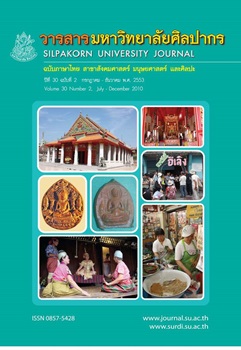การศึกษาการแปรของเสียง (mr) และ (ml ) ในภาษาไทยถิ่นสงขลา ตามปัจจัยทางสังคม A Study of the Variation by Social Variables of (mr) and (ml) in Songkhla Dialect
Main Article Content
Abstract
บทคัดย่อ
งานวิจัยนี้มีวัตถุประสงค์เพื่อศึกษาการแปรของเสียง (mr) และ (ml) ในภาษาไทยถิ่นสงขลา และศึกษาความสัมพันธ์ระหว่างการแปรของเสียงดังกล่าวกับปัจจัยทางสังคม ได้แก่ อายุ เพศ และถิ่นที่อยู่อาศัย โดยผู้วิจัยศึกษาตัวแปรอายุ 3 กลุ่ม ได้แก่ กลุ่มวัยรุ่น (อายุ 15-25 ปี) กลุ่มวัยผู้ใหญ่ (อายุ 35-45 ปี) และกลุ่มวัยชรา (อายุ55 ปีขึ้นไป) ตัวแปรเพศ ประกอบด้วยเพศชายและเพศหญิง และศึกษาตัวแปรถิ่นที่อยู่อาศัย 2 ถิ่น คือ ชุมชนเมือง(เขตเทศบาลนครสงขลา อำเภอเมืองสงขลา) และชุมชนชนบท (ตำบลเกาะใหญ่ อำเภอกระแสสินธุ์) ทั้งนี้ผู้วิจัยเก็บข้อมูล จากผู้บอกภาษาทั้งหมด 120 คน และใช้คำทดสอบทั้งหมด 25 คำเป็นคำที่มีเสียง (mr) 12 คำ และ (ml) 13 คำผลการศึกษาพบว่าเสียง (mr) มีรูปแปรทั้งหมด 14 รูปแปร โดยรูปแปร[m]ปรากฏมากที่สุด ส่วน (ml) มีรูปแปรทั้งหมด 6 รูปแปร รูปแปรที่ปรากฏมากที่สุด คือ[ml] จึงกล่าวได้ว่าขณะนี้เสียง (mr) และ (ml) ในภาษาไทยถิ่นสงขลากำลังเกิดการเปลี่ยนแปลง โดยเสียง (mr) มีแนวโน้มที่จะวิวัฒนาการเป็นเสียงพยัญชนะต้นเดี่ยวเร็วกว่าเสียง (ml) ที่ยังคงปรากฏการใช้เสียงพยัญชนะควบกล้ำดั้งเดิมในจำนวนมากที่สุดเมื่อวิเคราะห์ความสัมพันธ์ระหว่างการแปรของเสียงดังกล่าวกับปัจจัยทางสังคมทั้ง 3 ปัจจัยแบบไม่ควบคุมตัวแปร พบว่าปัจจัยอายุและถิ่นที่อยู่อาศัยมีความสัมพันธ์กับการแปรของเสียง (mr) และ (ml) ในภาษาไทยถิ่นสงขลา ส่วนปัจจัยเพศไม่มีความสัมพันธ์กับการแปรทางภาษาดังกล่าว และเมื่อวิเคราะห์ความสัมพันธ์แบบควบคุมตัวแปร พบว่าการแปรของเสียง (mr) มีความสัมพันธ์กับปัจจัยอายุและถิ่นที่อยู่อาศัย ส่วนปัจจัยเพศไม่มีความสัมพันธ์กับการแปรของเสียง (mr) เช่นเดียวกัน สำหรับการแปรของเสียง (ml) มีความสัมพันธ์กับปัจจัยทางสังคมทั้ง 3 ปัจจัย ทั้งนี้ปัจจัยทางสังคมที่มีความสัมพันธ์กับการแปรของเสียง (mr) และ (ml) มากที่สุด คือ ถิ่นที่อยู่อาศัยรองลงมาคือ อายุ และเพศ ตามลำดับ
คำสำคัญ : 1. การแปรของเสียง. 2. ภาษาไทยถิ่นใต้. 3. ปัจจัยทางสังคม.
Abstract
This research is intended to investigate whether the variation of (mr) and (ml) in Songkhla dialectcorrelates with social variables : the speaker ’s age, sex and locality. Included in this study are three agegroups : youth (15 - 25 years of age), adult (35 - 45 years of age) and senior adult (55 years old or more).The study covers two sexes : male and female. Two localities were selected : Muang district (Songkhlamunicipal area) representing an urbanspeech community and Krasaesin district (Tambol Kohyai) representinga rural speech community. The field work was carried out by the researcher using 25 test words (12 testwords of (mr) and 13 test words of (ml)) to elicit the data from 120 selected informants.The research results shows that (mr) has 14 variants : the dominant one is [m]. As regards (ml), it has 6variants : the dominant one is[ml]. It can be concluded that (mr) and (ml) in Songkhla dialect are in the processof sound change. (mr) is likely to become an initial consonant sound while (ml) is likely to remain a consonantcluster.Without controlling for the other social variables, it is found that (mr) and (ml) in Songkhla dialect varyaccording to the social variables: age and locality but not sex. When controlling for other variables, the results alsoshow that (mr) varies according to the social variables : age and locality but not sex. The (ml) sound varies accordingto each of the three social variables: age, sex, and locality. The speaker’s locality is the most significant variable of(mr) and (ml) while the speaker ’s sex is the least important variable. The speaker’s age is more significant thansex but not as significant as locality.
Keywords : 1. Phonological Variation. 2. Southern Thai Dialect. 3. Social Variables.


